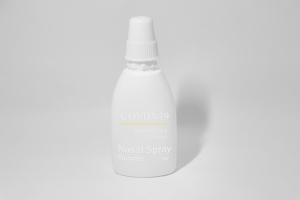
COVID-19 Vaccine Updates
 By Dr Satish K Gupta*
By Dr Satish K Gupta*
The world seems to be moving towards centuries-old techniques of sniffing vaccines. In the 18th century, Smallpox scab crushed powder used to be blown in the nose as a vaccine. Old seems to be turning gold.
Two needle-free COVID-19 vaccines have been approved for use in China and India respectively on September 5 and 6, 2022.
Let’s analyse them.
Why are nasal vaccines necessary?
The two nasal vaccines involve the use of a vaccination technology hitherto not popular in humans. China’s vaccine is inhaled by nebulization through the mouth and nose as an aerosol, while the Bharat Biotech vaccine is instilled as nasal drops. Both are designed to target the mucus membrane right where the SARS CoV -2 land –the Nasal Mucosa. They are purported to stimulate the formation of local IgA antibodies that coat the mucus membranes and entrap and neutralise the Covid-19 Virus. Thus, they can stop the virus from replicating at its entry and spreading to the lungs and other parts of the body. Scientists feel that mucosal vaccines might successfully prevent mild illnesses and block transmission to other people.
Are there any mucosal vaccines already approved against Covid-19?
Yes. Iran and Russia have already approved mucosal vaccines developed in their countries. RAZI Vaccine is already in use in Iran. Nearly 5000 doses have been used so far in Iran.
How many more such vaccines are in the development stage?
More than 100 mucosal vaccines against the disease are in development globally, and about 20 have reached clinical trials in humans.
China’s Nasal Vaccine
CanSino Biologics, Tianjin developed China’s inhaled vaccine and named it ‘Convidecia Air’. It is also called Ad5-nCoV. This vaccine has the same ingredients as the company’s COVID-19 injectable vaccine Ad5-nCoV available for more than a year. But the new avatar, ‘Convidecia Air’ comes in a nebulisable solution. This revised version has been approved to be used as a booster dose. Phase II study published in medRxive showed that aerosolised Ad5-nCoV following two-dose injectable CoronaVac was more immunogenic than three doses of injectable CoronaVac. It is noteworthy that CoronaVac is the most commonly used vaccine in China and is based on a killed virus vaccine platform. In addition, the vaccine used as a booster showed detectable Nab antibodies against omicron. However, there is a caveat: the immune responses produced by the inhaled vaccine wane over time.
It is noteworthy that CanSino’s initial one-shot injectable vaccine was 66% effective in preventing Covid-19 symptoms and 91% effective against severe disease.
India’s Nasal Vaccine
India’s vaccine, called iNCOVACC, developed by Bharat Biotech, has been approved as a two-dose primary inoculation for adults more than 18 years rather than a booster. However, the vaccine has also shown efficacy as a booster in trials (unpublished reports).
Bharat Biotech’s (Chimpanzee Adenovirus Vectored) ChAd36-SARS-CoV-S COVID-19 vaccine is a recombinant nasal vaccine. The vaccine has been developed in collaboration with the University of Washington, St Luis.
As per Bharat Biotech, the intra-nasal vaccine stimulates a broad immune response – neutralising IgG, mucosal IgA, and T Cell responses.
Two separate but simultaneous clinical trials were done to evaluate BBV154 as a primary 2- dose schedule; and a heterologous booster dose for subjects who have previously received 2 doses of the two covid vaccines (Covaxin and Covishield) in India.
Both trials were declared successful by the company. But trial data is still not in the public domain.
What are the Phase III trial results?
None of the companies has released Phase III trial data to the public.
How successful will nasal vaccines be?
It is challenging to answer presently. But one should not have very high expectations. After all, even the live virus instilled in the nose could not produce disease in more than 56% of people. So expecting a vaccine to stop transmission of a virus or prevent even mild illness — achieving what is called sterilising immunity — is a very high bar.
How long will the immunity persist?
IgA antibodies are prone to get washed in nasal secretions. How long they will stay and how quickly T cell responses take over is a matter of speculation. Nevertheless, as the incubation period of evolving variants is decreasing (Alpha 5 days, Delta 4.4 days and Omicron 3.4 days) and T cell responses may take time to get hooked up and respond, the mucosal immunity might play a crucial role in the initial days.
What is the experience with the Nasal vaccine used so far?
Two other mucosal COVID-19 vaccines already approved so far have published little data. First, a nasal spray made by Razi Vaccine was approved in Iran against COVID-19 in October 2021. Till now, nearly 5000 doses have been used. And Russia’s health ministry is reported to have approved an intranasal spray version of Sputnik V; the country’s injected COVID-19 vaccine.
Mucosal vaccines available against other diseases
Mucosal vaccines have been developed and used for other diseases, including poliovirus, influenza and cholera. Most of these vaccines are taken orally, but one, against flu, FluMist, is administered through the nose but is not very popular.
The decreasing COVID-19 cases
Meanwhile, the good news is that globally, the number of weekly COVID-19 cases decreased by 12% during the week of 29 August to 4 September 2022 as compared to the previous week, with just under 4.2 million new cases reported. The number of new weekly deaths decreased by 5% as compared to the previous week, with over 13 700 fatalities reported. As of 4 September 2022, over 600 million confirmed cases and over 6.4 million deaths have been reported globally.
At the country level, the highest numbers of new weekly cases were reported from Japan (1 164 787 new cases; -7%), the United States of America (586 509 new cases; +2%), the Republic of Korea (585 374 new cases; -21%), the Russian Federation (323 500 new cases; +12%) and China (238 044 new cases; +22%). The highest numbers of new weekly deaths were reported from the United States of America (3558 new deaths; +26%), Japan (2059 new deaths; +3%), Brazil (865 new deaths; -17%), the Russian Federation (628 new deaths; +20%) and the Republic of Korea (524 new deaths; similar to the previous week), according to the latest World Health Organization figures released today.
*Dr. Satish K Gupta is an MD in Medicines, a Visiting Senior Consultant Physician and Internist at Max Super Speciality Hospital, and a Clinical Assistant Professor at GS Medical College, Chaudhary Charan Singh University, Meerut. He is the author of Journey of COVID in India: A Doctor’s Perspective.






It’s a comparative review of nasal vaccines in World .